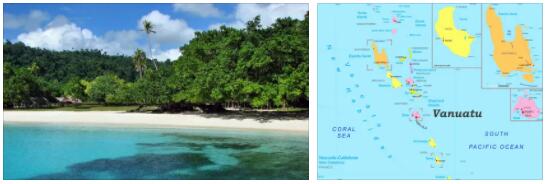Overview
The islands of Vanuatu are an adventure traveler’s paradise, as the geologically active archipelago offers scenic attractions ranging from colorful coral reefs to bubbling volcanoes and lush jungles. Visitors can drive to the rim of Yasur Volcano, said to be the most accessible volcano in the world, or sea kayak along the shores of the islands. Scuba dive to explore WWII wrecks, and hike or bike through the coconut plantations and tropical rainforest. Those who prefer to be less active will enjoy relaxing on the many beautiful sandy beaches, sample the multicultural cuisine of the capital, Port Vila, or hop from island to island on a charter boat. The islands of Efaté, Tanna and Espiritu Santo are particularly popular with tourists. International visitors land at Port Vila on Efaté and can explore the rest of the country by boat or plane. See other countries in Oceania on a2zgov.
Getting there
Arriving by plane
There are no direct flights to Vanuatu from Germany, Austria and Switzerland. Air Vanuatu (NF), the national carrier, connects Brisbane, Sydney, Melbourne (Australia), Auckland (New Zealand), Nouméa (New Caledonia) and Nadi (Fiji) with Vanuatu. Virgin Australia (VA) flies from Brisbane to Port Vila.
Flight times
Brisbane (Australia) – Port Vila: 2 hrs 50 mins; Auckland (New Zealand) – Port Vila: 3 hrs 50 mins; Nouméa (New Caledonia) – Port Vila: 1 hr 35 min; Nadi (Fiji) – Port Vila: 2 hrs 35 mins
Departure fee
Around €20 (2,800 VUV). Children under the age of 12 are exempt. The airport fees are usually included in the ticket price.
Arrival by car
Tolls: There are no tolls on the roads of Vanuatu. Documents: In addition to the national driver’s license, the international driver’s license is required.
Arrival by ship
The largest international ports are Port Vila and Santo.
Cruise ships
MSC also calls at Port Vila on its world cruise voyages departing from European ports. In Australia, shipping companies such as Cunard, Royal Caribbean, Celebrity Cruises, Carnival and Silversea start their cruises with stopovers in Vanuatu.
Transportation
Traveling by plane
The national airline Air Vanuatu (NF) flies to numerous domestic destinations. The islands of Tanna and Espiritu Santo are served daily from Port Vila, with less frequent scheduled flights to the other islands. Charter flights can be booked with Unity Airlines. Helicopter flights are available with Vanuatu Helicopters.
Departure fee
A fee of approximately €1.50 (200 VUV) is charged on departure on all domestic flights.
Traveling by car/bus
The road network has a total length of around 1,000 km. Tolls: Vanuatu’s roads do not have tolls. Petrol stations are only available in the cities. When traveling overland, it is advisable to fill up the tank beforehand or to carry a full reserve canister with you.
Right-hand traffic/left-hand traffic
Right
Condition of the roads
About a quarter of the streets are paved; the rest is unpaved. Outside the villages, the roads are difficult to drive on, especially after heavy rainfall; Four-wheel drive vehicles are recommended. Between the villages of smaller islands there are often only footpaths.
Car rental
Car hire is available in Port Vila at the airport and in town. Drivers must be at least 23 years old; with some car rental companies also 25 years, with at least 1 year of driving experience.
Taxi
Taxis are plentiful. Standard fares apply to travel from the airport and to most accommodation in Port Vila. When driving in Port Vila, the fare should be agreed before departure. There are no taximeters.
Bicycle
Bicycles can be rented at some resorts; in Port Vila also scooters. Vanuatu Ecotours offers, among other things, mountain bike tours.
Coach
There is no regular bus service. However, some minibus owners offer transportation around the island.
Regulations
Traffic regulations: – Helmets are compulsory for motorcyclists. Speed limits: – in built-up areas: 50 km/h; – extra-urban: 80 km/h.
Roadside Assistance
The ADAC foreign emergency call offers ADAC members and holders of ADAC foreign health and accident insurance comprehensive assistance in the event of vehicle breakdowns, traffic accidents, loss of documents and money, and medical emergencies. The emergency number is available around the clock; in the event of damage to the vehicle: Tel. +49 (0)89 22 22 22, in the event of illness: +49 (0)89 76 76 76. In the event of breakdowns or accidents with the rental car, the car rental company should be contacted first.
Documentation
In addition to the national driver’s license, the international driver’s license is required.
Traveling in the city
Minibuses operate in Port Vila and can be hailed almost anywhere. They are marked with a B on the license plate.
Locally on the way by train
There is no rail transport on the islands.
Traveling by ship
Ferries from Vanuatu Ferry and Big Sista serve the Port Vila – Malekula – Luganville route (journey time: approx. 24 hours). Both companies often make numerous additional stops, depending on passenger demand or freight transport, such as on islands such as Emae, Epi, Paama and Maskelynes. Various smaller ships sail from Santo to Malekula; further information is available on the quay in Luganville. Boats connect much of the rest of the islands.
